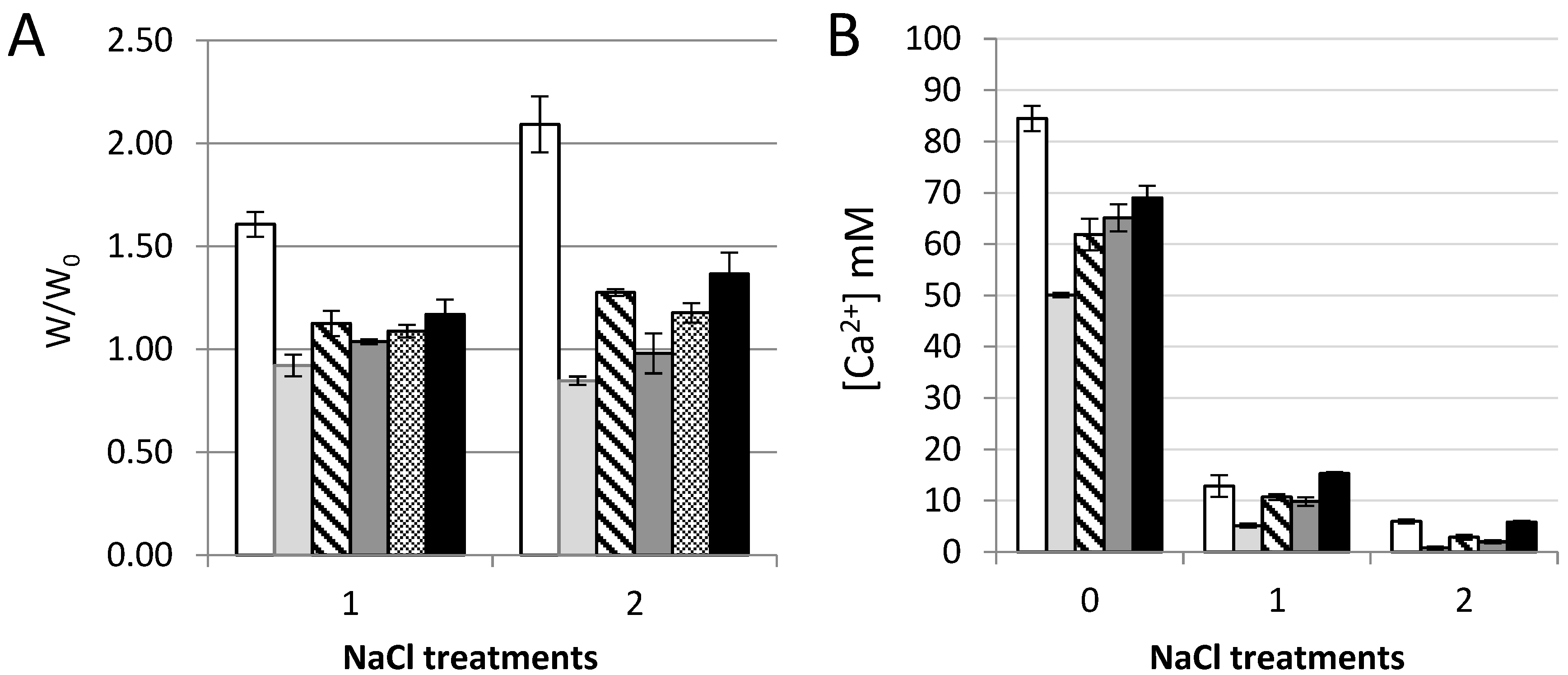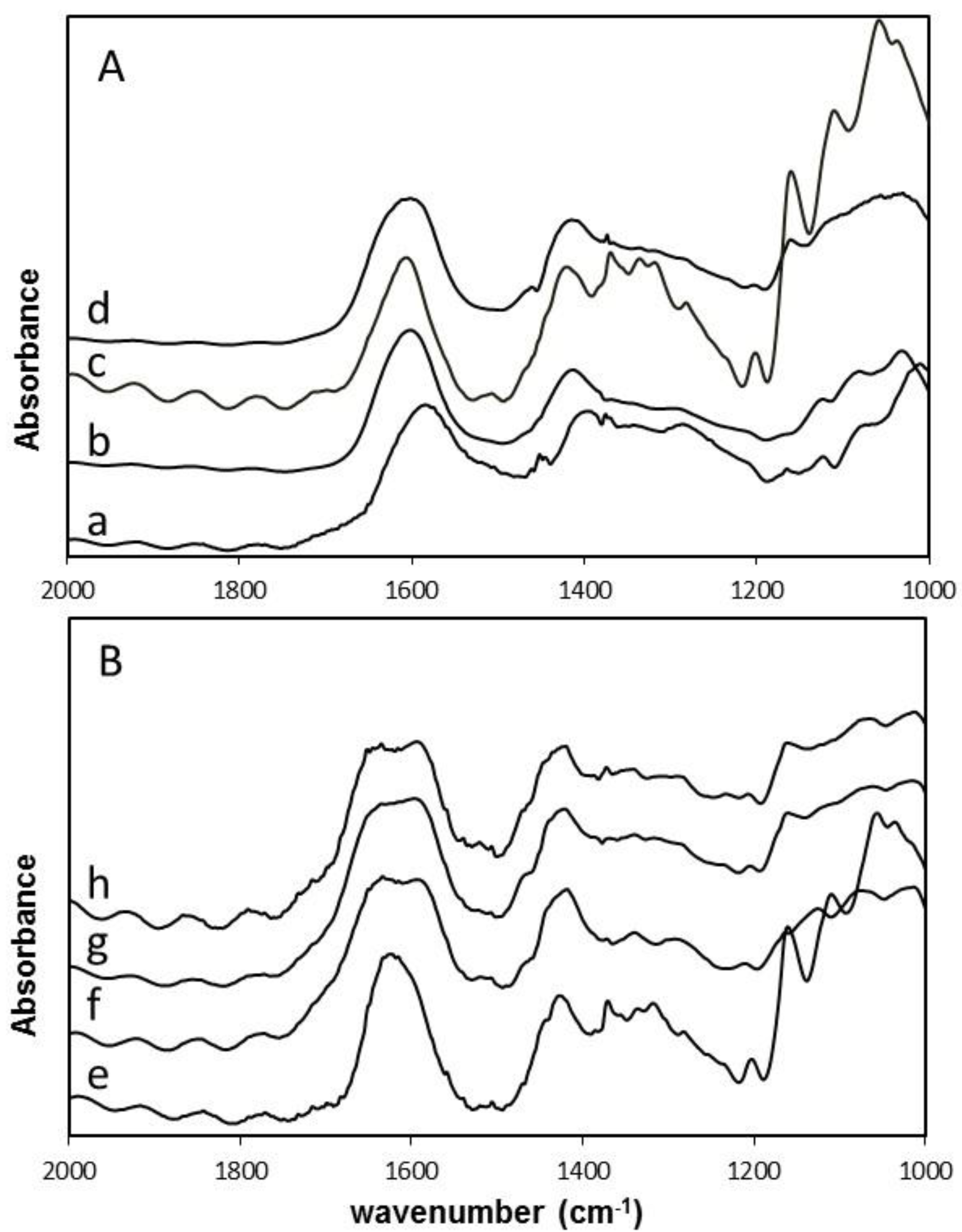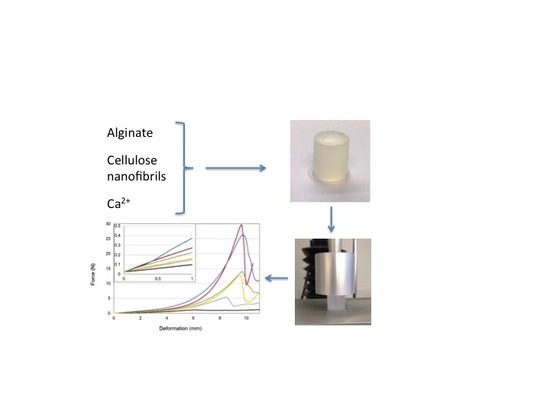1. Introduction
Recently, composite materials of alginate and cellulose nanofibrils (CNF) have shown promising results for bioprinting and tissue engineering applications [
1,
2,
3]. In particular, the shear thinning properties of CNF combined with the viscous alginate that form hydrogels with divalent cations at physiological conditions, are attractive for bioprinting [
1].
Alginates are linear copolymers of 1 → 4 linked β-
d-mannuronic acid (M) and α-
l-guluronic acid (G). The monomers are arranged in a block-wise pattern along the chain with homopolymeric regions of M and G termed M- and G-blocks, respectively, interspaced with regions of alternating structure (MG-blocks) [
4]. Alginate forms hydrogels by crosslinking with divalent cations where, particularly, the G-blocks, but also the MG-blocks, are important for the mechanical properties of the resulting gel [
5,
6]. Alginate hydrogels can be produced under physiological conditions [
7,
8]. This, together with a low immunogenic profile [
9], makes them popular materials for biomedical applications and, in particular, in tissue engineering [
10]. Cellulose provides structural support in plant cell walls and can be processed as fibres or nanoscaled fibrils of cellulose, known as cellulose nanofibrils (CNF). Several procedures for preparation of CNF from cellulose pulp exist, among them 2,2,6,6-tetramethylpiperidine-1-oxyl radical (TEMPO)-mediated oxidation using sodium hypochlorite as oxidant [
11]. By this, aldehyde and carboxyl groups are introduced on the surfaces of the cellulose fibrils and increase the negative charge of the fibrils. Aqueous dispersions of CNF have gel like character at low concentrations (approx. 0.5%) held together by fibril entanglement and hydrogen bonds. CNF hydrogels can be produced with cations, both monovalent and with higher valency [
12], where gels with higher valency ions form stronger gels [
12,
13].
Due to their availability, renewability, biocompatibility, and low toxicity, both alginate and cellulose are attractive materials for a range of applications such as films, gels, and as viscosifiers. Although being suggested for tissue engineering applications, not much is known about the mechanical properties of composite gels of alginate and CNF. Composite gels of alginate and either oxidized CNC (cellulose nanocrystals) or CNF have shown increased compression strength, suggested to be the result of Ca
2+ mediated crosslinking of the two components [
14]. TEMPO-oxidized BNC (bacterial nanocellulose) have been used to improve the mechanical and chemical stability of an alginate hydrogel, and the composite gel was used for encapsulation of fibroblasts. The nanofibrous structure of the BNC was suggested to mimic the fibre structures of collagen and fibronectin found in the extracellular matrix [
15,
16,
17], and fibroblast viability and proliferation was found to be higher in comparison to pure alginate gels [
18]. For chondrocytes, the combination of sulfated alginate with nanocellulose were promising regarding cell viability and phenotype [
2]. It has previously been shown that Young’s modulus of the matrix is important for the development of stem cells into differentiated cell types/tissues [
19]. Hence, the structure, chemistry, as well as the mechanical properties are of importance in tissue engineering applications. Although composite gels of CNF and alginate have been demonstrated in the literature, a systematic study of mechanical properties on combinations of different types of alginate and CNF has not yet been reported.
We hypothesize that by combining alginate and CNF, the advantageous properties of the individual constituents, i.e., the stiffness of CNF and the compressibility of alginate, could be preserved in the composite gel making it possible to tailor the mechanical properties.
2. Materials and Methods
2.1. Materials
Alginates: Alginates extracted from
Durvillea potatorum and
Laminaria hyperborea stipe were obtained from FMC Health and Nutrition (Sandvika, Norway), and
Macrocystis pyrifera alginate were purchased from Sigma-Aldrich (St. Louis, MO, USA). Molecular weight and NMR parameters are given
Table 1. For a detailed study on alginate fine structure see [
20].
Nanocellulose: Never-dried bleached kraft softwood pulp fibres were used as the source material for production of two types of nanocellulose. The first type was produced using a mechanical pretreatment (beating in a Claflin mill; 1000 kWh/ton for 1 h) followed by homogenization (denoted as mechanically-fibrillated CNF). Production of the second type (referred to as oxidized CNF) was performed using TEMPO-mediated oxidation as pretreatment, as described by Saito and colleagues [
11]. NaClO (2.3 mmol per gram of cellulose) was used in the oxidation. The fibrillation was done by using a Rannie 15 type 12.56x homogenizer (APV, SPX Flow Technology, Silkeborg, Denmark) with a pressure drop of 1000 bar in each pass. Mechanically-fibrillated CNF was homogenized using five passes, the oxidized CNF using 1 pass. The concentration of the pretreated samples was 1% (
w/
v) before fibrillation.
The composition of carbohydrates was determined according to the standard method NREL/TP-510-42618, using sulphuric acid hydrolysis. The composition of carbohydrate monomers produced during the hydrolysis was analysed using high-performance anion-exchange chromatography with pulsed amperometric detection (HPAEC-PAD; Dionex ICS-5000, (Thermo Fisher Scientific, Waltham, MA, USA) with a CarboPac PA1 column (Thermo Fisher Scientific, Waltham, MA, USA) and gradient elution using sodium hydroxide for elution. The carbohydrate composition of the two CNF samples is shown in
Appendix A.
The intrinsic viscosity was determined as described in ISO-standard 5351:2010, using cupriethylenediamine (CED) as a solvent. The oxidized CNF was subjected to a second oxidation before the analysis. This is due to a significant amount of aldehyde groups in the oxidized samples which induce depolymerization through a β-elimination reaction [
21]. In order to avoid this, a selective oxidation of the aldehyde groups was performed using sodium chlorite under acidic conditions.
The carboxylate content was determined using conductometric titration as previously described [
22,
23]. The equipment used was a 902 Titrando, an 856 conductivity module and Tiamo software (Metrohm). Residual fibres were quantified with a FibreTester device, as previously described by Chinga-Carrasco and colleagues [
24]. The fibrillated structure and analyses of the fibre structure from atomic force microscopy (AFM) imaging with resulting characteristics of the cellulose nanofibrils have previously been described [
25]. A summary of nanocellulose characteristics is shown in
Appendix A.
Control polymers: Hyaluronic acid (Mw = 8.7 × 105 Da) was a gift from Novamatrix (Norway), xanthan (Mw = 9.6 × 105 Da) was a gift from CP Kelco (USA), and dextran (Mw = 2.0 × 106 Da) was purchased from Pharmacia AB (Stockholm, Sweden). The molecular weight of the samples were determined using a HPLC system consisting of serially connected TSK G6000 PWxl and G5000PWxl columns (Tosoh Bioscience LLC, Tokyo, Japan) followed by a Dawn Helios II MALLS photometer and an Optilab T-rEX differential refractometer (Wyatt Technology, Santa Barbara, CA, USA). The elution buffer (0.15 M NaNO3 with 1 mM EDTA, pH 6.0) was applied at a flow rate of 0.5 mL/min. Data were collected and processed using ASTRA 6.1 software. Refractive index increment values (dn/dc) used in the calculations were set to 0.148 for dextran and 0.150 for alginate, hyaluronic acid and xanthan.
2.2. Preparation of Gel Cylinders
Alginate gels were prepared by internal gelling with CaCO
3 and
d-glucono δ-lactone (GDL) as previously described [
26]. Briefly, CaCO
3 (56.25 mg, particle size 4 µm) suspended in 5 mL MQ water was added to 25 mL, 1.5% (
w/
v) of alginate solution. The mixture was degassed under vacuum suction before addition of 7.5 mL of a freshly made solution of
GDL (200.36 mg). The mixture was immediately poured into 24-well tissue culture plates (16/18 mm, Costar, Cambridge, MA, USA) and left at room temperature for minimum 20 h. The gel cylinders were removed from the tissue culture plates and weight was measured on the calcium unsaturated gels before being immersed in a solution of 50 mM CaCl
2 and 200 mM NaCl (100 mL per gel) and left for 24 h at 4 °C for calcium saturation before syneresis and compression measurement.
Two-component gels of alginate and either xanthan, dextran or hyaluronic acid were made by a simillar procedure as for pure alginate gels. The two components were dissolved together in 25 mL MQ water, yielding a final concentration in the gelling solution of 1% (w/v) M. pyrifera alginate and 0.30% or 0.75% (w/v) of the other component.
Alginate—CNF composite gels were made by mixing 450 mg alginate powder with MQ water and CNF dispersion corresponding to final concentrations of 1% (w/v) alginate and 0.15–0.75% (w/v) CNF and a total volume of 30 mL. The blends were dissolved for at least 18 h under constant stirring and homogenized for 5 min with a Vdi 12 Ultra Turrax at 11,500 rpm. Twenty-five grams of the blend was weighed out and added CaCO3 and GDL as described above.
2.3. Syneresis and Gel Strength Measurements
Syneresis was determined after calcium saturation as (W
0 − W)/W
0) × 100, where W
0 and W are the initial weights of the samples before calcium saturation and final weights of the calcium saturated gels, respectively. Force/deformation curves was recorded at 22 °C on a Stable Micro Systems TA-XT2 texture analyser equipped with a P/35 probe and at a compression rate of 0.1 mm/s [
26]. The gels were subjected to uniaxial compression surpassing the point of rupture, where force and deformation was recorded. Young’s modulus was calculated as G·(h/A) where G is the initial slope (N/m) of the stress deformation curve and h and A is the height and area of the gel cylinder, respectively. In order to compare Young’s modulus of gels with different degree of syneresis, the relationship E = k·c
2 was applied [
27] where k is characteristic for each type of alginate, and c is the weight concentration.
2.4. Volume Stability and Calcium Binding
The weight and calcium content of pure and composite gels of M. pyr. alginate and oxidized CNF were measured before and after saline treatments. Gel cylinders immersed in a solution of 50 mM CaCl2 and 200 mM NaCl for 24 h were cut in three approximately equal pieces, weighed and immersed separately in 40 mL of 150 mM NaCl solution at room temperature for 24 h. The gel pieces were gently removed from the solution, weighed and subjected to a second saline treatment. After weighing, the gels were added 0.5 mL of 100 mM Na-EDTA, pH = 7.0. All samples were vortexed and centrifuged (2400 rpm, 5 min) before they were diluted 100 × in 5% HNO3 and calcium content analysed with ICP-MS (type 8800 Triple Quadrupole ICP-MS with ASX-520 Autosampler from Agilent Technologies, Santa Clara, CA, USA). As internal standards 115In and 89Y were used.
2.5. Light Microscopy
Homogeneity of the gels were assessed on a Nikon Eclipse TS100 microscope (Nikon Instruments, Tokyo, Japan) by placing a drop of gelling solution between two microscopy slides and observing the gellation in the microscope using 40 × magnification.
2.6. Preparation of Aerogels for Scanning Electron Microscopy (SEM)
After the gels had been cast, the cylinders where cut, in the hydrated state, into 200 µm thick sections using a vibrating blade microtome (VT1000S, Leica Biosystems, Nussloch GmBH, Wetzlar, Germany). The sections where dehydrated in increasing concentrations of ethanol, before substitution with acetone and finally critical-point dried using liquid CO2 (Emitech K850 critical point dryer, Quorum Technologies, Lewes, UK). The sections were mounted on aluminum stubs using carbon tape and sputter coated (208 HR, Cressington, Watford, UK) with a 5 nm layer of Pt/Pd (80/20). SEM analysis was performed with an acceleration voltage of 5 kV (S-5500 S(T)EM, Hitachi, Tokyo, Japan).
2.7. Fourier Transform Infrared Spectroscopy (FTIR) Characterization
The infrared spectra of vacuum dried samples were collected on a Bio-Rad Excalibur series FTS 3000 spectrophotometer (Bio-Rad, Hercules, CA, USA). The spectra were acquired in transmission mode on the films at a spectral range of 4000−500 cm−1.
2.8. Statistical Analysis
All values are expressed as means ± standard deviations. Comparisons between groups were made using a two-sided Student’s t-test and Microsoft Excel worksheet (2011). Statistical outcomes (
p-values) are presented in
Appendix B.
 ), 1% (w/v) M. pyr. + 0.15% (w/v) ox. CNF (
), 1% (w/v) M. pyr. + 0.15% (w/v) ox. CNF (  ), 1% (w/v) M. pyr. + 0.30% (w/v) ox. CNF (
), 1% (w/v) M. pyr. + 0.30% (w/v) ox. CNF (  ), 1% (w/v) M. pyr + 0.50% (w/v) ox. CNF (
), 1% (w/v) M. pyr + 0.50% (w/v) ox. CNF (  ) and 1% (w/v) M. pyr + 0.75% (w/v) ox. CNF (
) and 1% (w/v) M. pyr + 0.75% (w/v) ox. CNF (  ); (B) 0.75% (w/v) M. pyr (
); (B) 0.75% (w/v) M. pyr (  ), 0.75% (w/v) ox. CNF (
), 0.75% (w/v) ox. CNF (  ), 0.375% (w/v) ox. CNF + 0.375% (w/v) M. pyr (
), 0.375% (w/v) ox. CNF + 0.375% (w/v) M. pyr (  ), 0.75% (w/v) ox. CNF + 0.2% (w/v) M. pyr (
), 0.75% (w/v) ox. CNF + 0.2% (w/v) M. pyr (  ), 0.75% (w/v) ox. CNF + 0.375% (w/v) M. pyr (
), 0.75% (w/v) ox. CNF + 0.375% (w/v) M. pyr (  ) and 0.75% (w/v) ox. CNF + 0.75% (w/v) M. pyr (
) and 0.75% (w/v) ox. CNF + 0.75% (w/v) M. pyr (  ).
).
 ), 1% (w/v) M. pyr. + 0.15% (w/v) ox. CNF (
), 1% (w/v) M. pyr. + 0.15% (w/v) ox. CNF (  ), 1% (w/v) M. pyr. + 0.30% (w/v) ox. CNF (
), 1% (w/v) M. pyr. + 0.30% (w/v) ox. CNF (  ), 1% (w/v) M. pyr + 0.50% (w/v) ox. CNF (
), 1% (w/v) M. pyr + 0.50% (w/v) ox. CNF (  ) and 1% (w/v) M. pyr + 0.75% (w/v) ox. CNF (
) and 1% (w/v) M. pyr + 0.75% (w/v) ox. CNF (  ); (B) 0.75% (w/v) M. pyr (
); (B) 0.75% (w/v) M. pyr (  ), 0.75% (w/v) ox. CNF (
), 0.75% (w/v) ox. CNF (  ), 0.375% (w/v) ox. CNF + 0.375% (w/v) M. pyr (
), 0.375% (w/v) ox. CNF + 0.375% (w/v) M. pyr (  ), 0.75% (w/v) ox. CNF + 0.2% (w/v) M. pyr (
), 0.75% (w/v) ox. CNF + 0.2% (w/v) M. pyr (  ), 0.75% (w/v) ox. CNF + 0.375% (w/v) M. pyr (
), 0.75% (w/v) ox. CNF + 0.375% (w/v) M. pyr (  ) and 0.75% (w/v) ox. CNF + 0.75% (w/v) M. pyr (
) and 0.75% (w/v) ox. CNF + 0.75% (w/v) M. pyr (  ).
).
 ) and oxidized CNF (
) and oxidized CNF (  ). Bars are means ± standard deviations, shown for n = 5–8 gels. P-values are presented in Table A3 and Table A4 in Appendix B.
). Bars are means ± standard deviations, shown for n = 5–8 gels. P-values are presented in Table A3 and Table A4 in Appendix B.
 ) and oxidized CNF (
) and oxidized CNF (  ). Bars are means ± standard deviations, shown for n = 5–8 gels. P-values are presented in Table A3 and Table A4 in Appendix B.
). Bars are means ± standard deviations, shown for n = 5–8 gels. P-values are presented in Table A3 and Table A4 in Appendix B.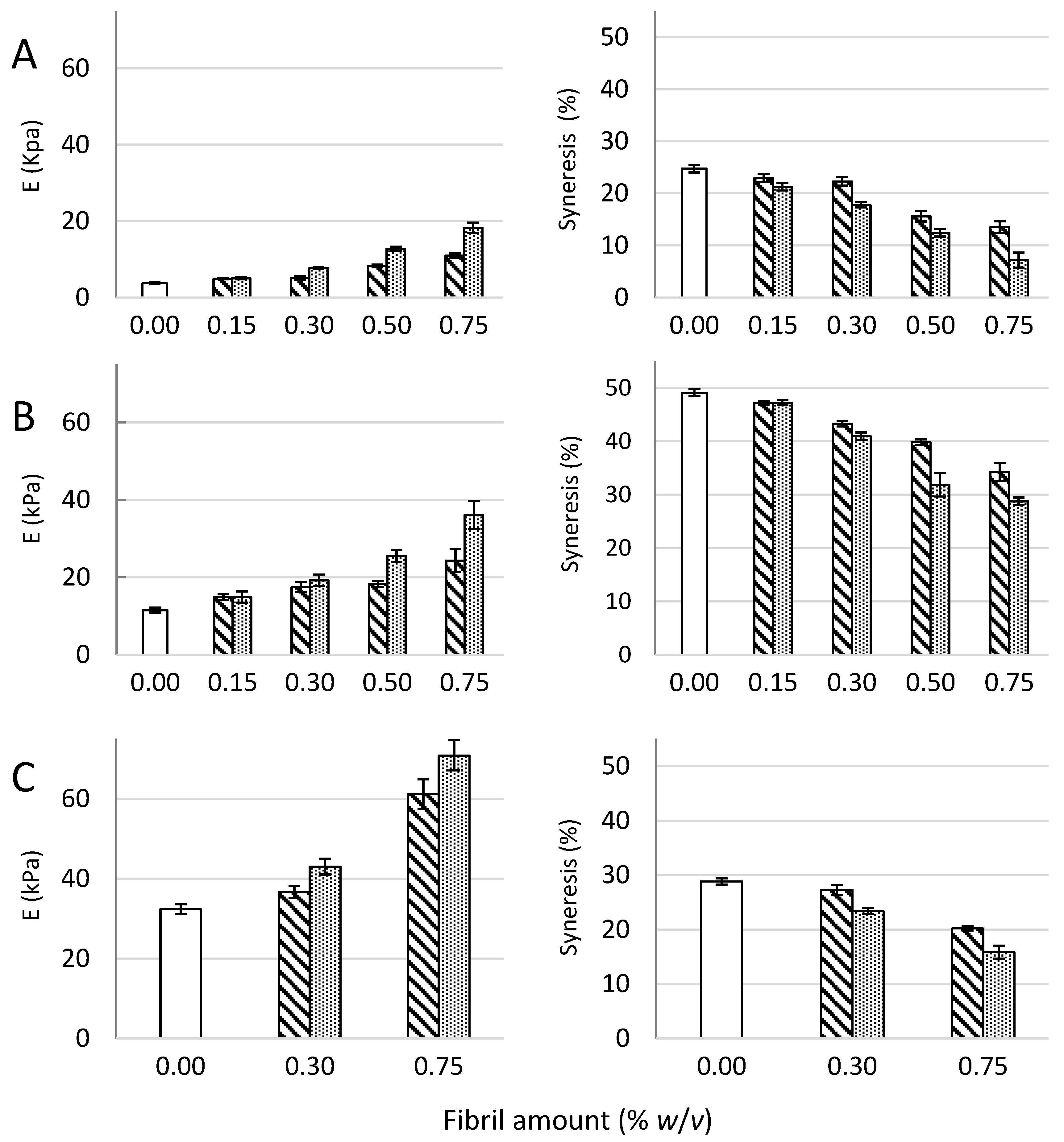
 ) and oxidized (
) and oxidized (  ) CNF. Bars are means +/− standard deviations, shown for n = 5–8 gels. P-values are presented in Table A3 and Table A4 in Appendix B.
) CNF. Bars are means +/− standard deviations, shown for n = 5–8 gels. P-values are presented in Table A3 and Table A4 in Appendix B.
 ) and oxidized (
) and oxidized (  ) CNF. Bars are means +/− standard deviations, shown for n = 5–8 gels. P-values are presented in Table A3 and Table A4 in Appendix B.
) CNF. Bars are means +/− standard deviations, shown for n = 5–8 gels. P-values are presented in Table A3 and Table A4 in Appendix B.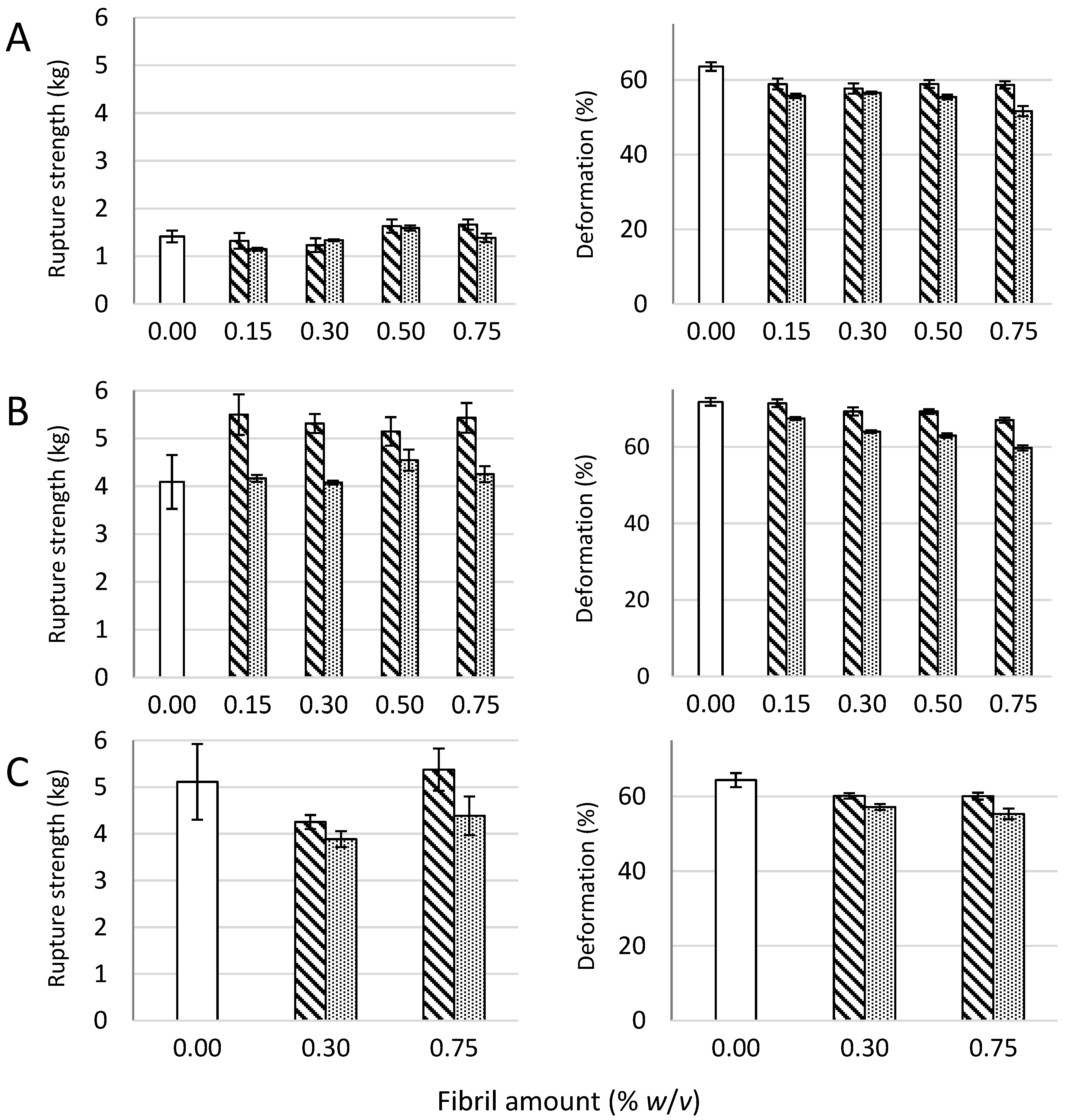
 ), a pure (0.75% w/v) oxidized CNF gel (
), a pure (0.75% w/v) oxidized CNF gel (  ), and composite gels of 0.75% (w/v) of each of the two materials (
), and composite gels of 0.75% (w/v) of each of the two materials (  ). Mean +/− standard deviation shown for n = 5–8 gels.
). Mean +/− standard deviation shown for n = 5–8 gels.
 ), a pure (0.75% w/v) oxidized CNF gel (
), a pure (0.75% w/v) oxidized CNF gel (  ), and composite gels of 0.75% (w/v) of each of the two materials (
), and composite gels of 0.75% (w/v) of each of the two materials (  ). Mean +/− standard deviation shown for n = 5–8 gels.
). Mean +/− standard deviation shown for n = 5–8 gels.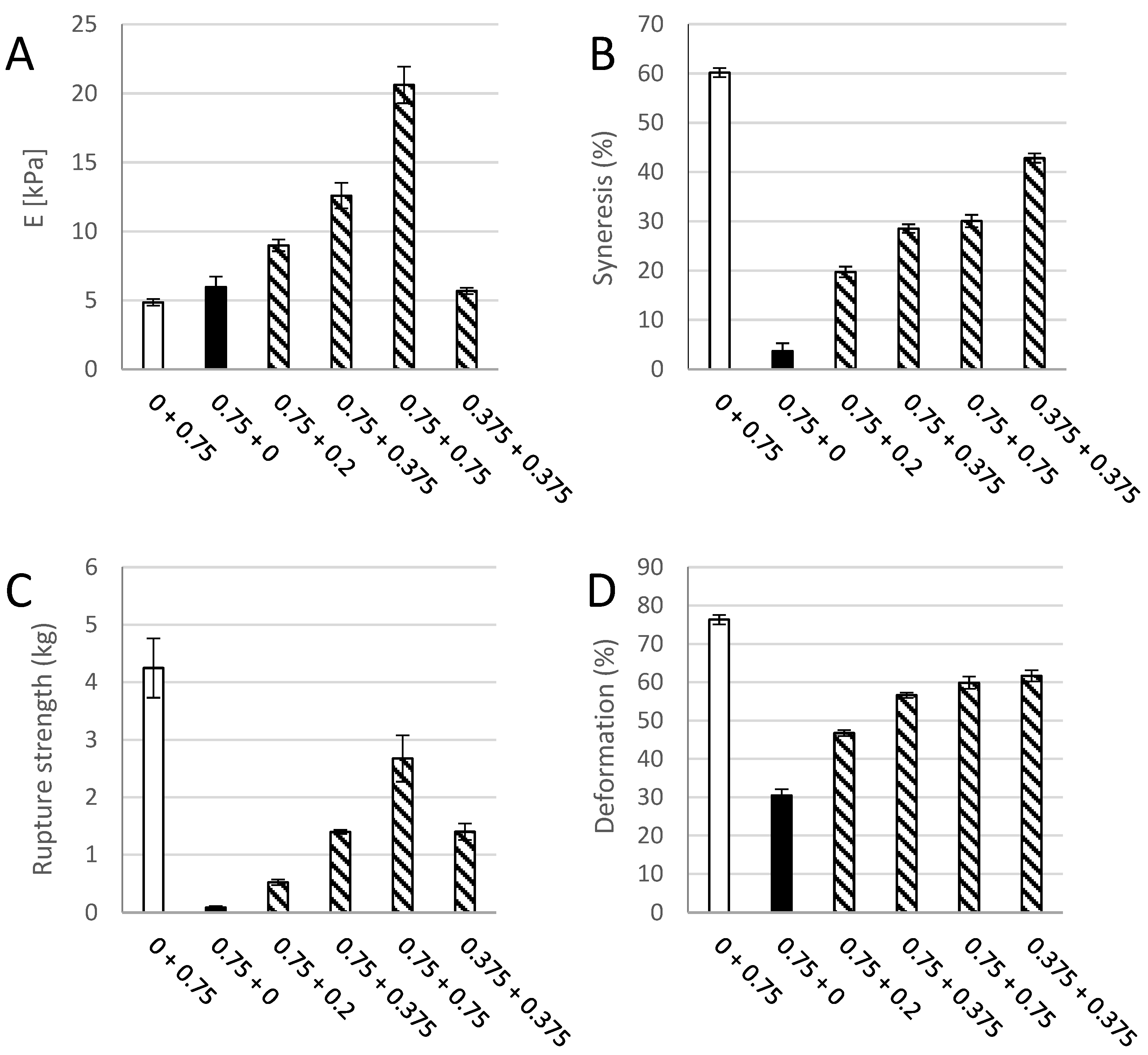
 ), dextran (
), dextran (  ), hyaluronic acid (
), hyaluronic acid (  ), xanthan (
), xanthan (  ), mechanically-fibrillated CNF (
), mechanically-fibrillated CNF (  ) and oxidized CNF (
) and oxidized CNF (  ). Bars are means +/− standard deviations, shown for n = 5–9 gels. P-values are presented in Table A5 and Table A6 in Appendix B.
). Bars are means +/− standard deviations, shown for n = 5–9 gels. P-values are presented in Table A5 and Table A6 in Appendix B.
 ), dextran (
), dextran (  ), hyaluronic acid (
), hyaluronic acid (  ), xanthan (
), xanthan (  ), mechanically-fibrillated CNF (
), mechanically-fibrillated CNF (  ) and oxidized CNF (
) and oxidized CNF (  ). Bars are means +/− standard deviations, shown for n = 5–9 gels. P-values are presented in Table A5 and Table A6 in Appendix B.
). Bars are means +/− standard deviations, shown for n = 5–9 gels. P-values are presented in Table A5 and Table A6 in Appendix B.

 ), 0.75% (w/v) oxidized CNF (
), 0.75% (w/v) oxidized CNF (  ), 0.375% (w/v) oxidized CNF + 0.375% (w/v) M. pyr. (
), 0.375% (w/v) oxidized CNF + 0.375% (w/v) M. pyr. (  ), 0.75% (w/v) oxidized CNF + 0.2% (w/v) M. pyr. (
), 0.75% (w/v) oxidized CNF + 0.2% (w/v) M. pyr. (  ), and 0.75% (w/v) oxidized CNF + 0.75% (w/v) M. pyr. (
), and 0.75% (w/v) oxidized CNF + 0.75% (w/v) M. pyr. (  ). Mean ± standard deviation are shown for three gels.
). Mean ± standard deviation are shown for three gels.
 ), 0.75% (w/v) oxidized CNF (
), 0.75% (w/v) oxidized CNF (  ), 0.375% (w/v) oxidized CNF + 0.375% (w/v) M. pyr. (
), 0.375% (w/v) oxidized CNF + 0.375% (w/v) M. pyr. (  ), 0.75% (w/v) oxidized CNF + 0.2% (w/v) M. pyr. (
), 0.75% (w/v) oxidized CNF + 0.2% (w/v) M. pyr. (  ), and 0.75% (w/v) oxidized CNF + 0.75% (w/v) M. pyr. (
), and 0.75% (w/v) oxidized CNF + 0.75% (w/v) M. pyr. (  ). Mean ± standard deviation are shown for three gels.
). Mean ± standard deviation are shown for three gels.